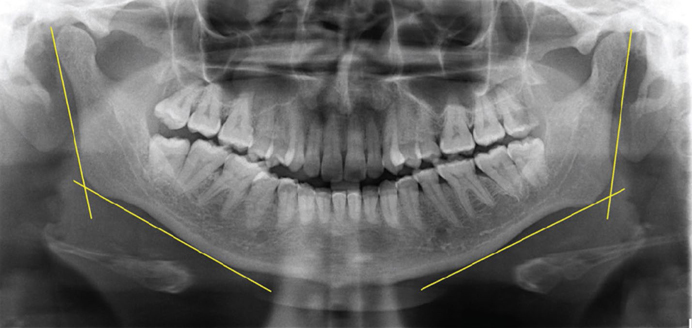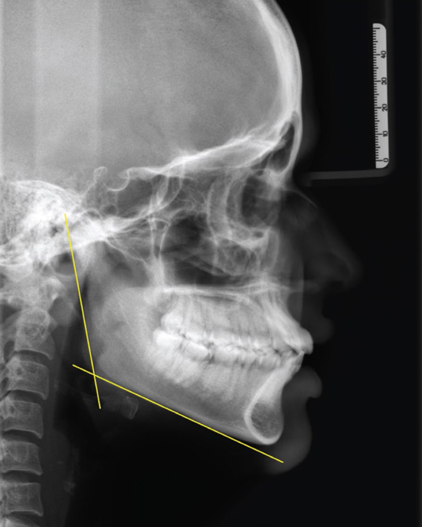Imaging Sci Dent.
2017 Jun;47(2):93-97. 10.5624/isd.2017.47.2.93.
Dilemma of gonial angle measurement: Panoramic radiograph or lateral cephalogram
- Affiliations
-
- 1Department of Orthodontics, Amrita School of Dentistry, Kochi, India. sapnavarmank@hotmail.com
- KMID: 2389889
- DOI: http://doi.org/10.5624/isd.2017.47.2.93
Abstract
- PURPOSE
The purpose of this study was to evaluate the accuracy of panoramic imaging in measuring the right and left gonial angles by comparing the measured angles with the angles determined using a lateral cephalogram of adult patients with class I malocclusion.
MATERIALS AND METHODS
The gonial angles of 50 class I malocclusion patients (25 males and 25 females; mean age: 23 years) were measured using both a lateral cephalogram and a panoramic radiograph. In the lateral cephalograms, the gonial angle was measured at the point of intersection of the ramus plane and the mandibular plane. In the panoramic radiographs, the gonial angle was measured by drawing a line tangent to the lower border of the mandible and another line tangent to the distal border of the ascending ramus and the condyle on both sides. The data obtained from both radiographs were statistically compared.
RESULTS
No statistically significant difference was observed between the gonial angle measured using the lateral cephalograms and that determined using the panoramic radiographs. Further, there was no statistically significant difference in the measured gonial angle with respect to gender. The results also showed a statistically insignificant difference in the mean of the right and the left gonial angles measured using the panoramic radiographs.
CONCLUSION
As the gonial angle measurements using panoramic radiographs and lateral cephalograms showed no statistically significant difference, panoramic radiography can be considered in orthodontics for measuring the gonial angle without any interference due to superimposed images.
Keyword
Figure
Reference
-
1. Xiao D, Gao H, Ren Y. Craniofacial morphological characteristics of Chinese adults with normal occlusion and different skeletal divergence. Eur J Orthod. 2011; 33:198–204.
Article2. Nanda SK. Growth patterns in subjects with long and short faces. Am J Orthod Dentofacial Orthop. 1990; 98:247–258.
Article3. Tahmina K, Tanaka E, Tanne K. Craniofacial morphology in orthodontically treated patients of class III malocclusion with stable and unstable treatment outcomes. Am J Orthod Dentofacial Orthop. 2000; 117:681–690.
Article4. Upadhyay RB, Upadhyay J, Agrawal P, Rao NN. Analysis of gonial angle in relation to age, gender and dentition status by radiological and anthropometric methods. J Forensic Dent Sci. 2012; 4:29–33.
Article5. Larheim TA, Svanaes DB. Reproducibility of rotational panoramic radiography: mandibular linear dimensions and angles. Am J Orthod Dentofacial Orthop. 1986; 90:45–51.
Article6. Graber TM. Panoramic radiography in orthodontic diagnosis. Am J Orthod. 1967; 53:799–821.
Article7. Mattila M, Könönen M, Mattila K. Vertical asymmetry of the mandibular ramus and condylar heights measured with a new method from dental panoramic radiographs in patients with psoriatic arthritis. J Oral Rehabil. 1995; 22:741–745.
Article8. McDavid WD, Tronje G, Welander U, Morris CR. Effects of errors in film speed and beam alignment on the image layer in rotational panoramic radiography. Oral Surg Oral Med Oral Pathol. 1981; 52:561–564.
Article9. Yeo DK, Freer TJ, Brockhurst PJ. Distortions in panoramic radiographs. Aust Orthod J. 2002; 18:92–98.10. Mattila K, Altonen M, Haavikko K. Determination of the gonial angle from the orthopantomogram. Angle Orthod. 1977; 47:107–110.11. Dahan J, Jesdinsky HJ. Evaluation of the orthopantomogram for cephalometric studies in orthodontics. Stoma (Heidelb). 1968; 21:200–206.12. Bhullar MK, Uppal AS, Kochhar GK, Chachra S, Kochhar AS. Comparison of gonial angle determination from cephalograms and orthopantomogram. Indian J Dent. 2014; 5:123–126.
Article13. Shahabi M, Ramazanzadeh BA, Mokhber N. Comparison between the external gonial angle in panoramic radiographs and lateral cephalograms of adult patients with Class I malocclusion. J Oral Sci. 2009; 51:425–429.
Article14. Araki M, Kiyosaki T, Sato M, Kohinata K, Matsumoto K, Honda K. Comparative analysis of the gonial angle on lateral cephalometric radiographs and panoramic radiographs. J Oral Sci. 2015; 57:373–378.
Article15. Alhaija ES. Panoramic radiographs: determination of mandibular steepness. J Clin Pediatr Dent. 2005; 29:165–166.16. Dutra V, Yang J, Devlin H, Susin C. Mandibular bone remodeling in adults: evaluation of panoramic radiographs. Dentomaxillofac Radiol. 2004; 33:323–328.17. Ghosh S, Vengal M, Pai KM, Abhishek K. Remodeling of the antegonial angle region in the human mandible: a panoramic radiographic cross-sectional study. Med Oral Patol Oral Cir Bucal. 2010; 15:e802–e807.
Article18. Bhardwaj D, Kumar JS, Mohan M. Radiographic evaluation of mandible to predict the gender and age. J Clin Diagn Res. 2014; 8:ZC66–ZC69.
Article19. Huumonen S, Sipilä K, Haikola B, Tapio M, Söderholm AL, Remes-Lyly T, et al. Influence of edentulousness on gonial angle, ramus and condylar height. J Oral Rehabil. 2010; 37:34–38.
Article20. Xie QF, Ainamo A. Correlation of gonial angle size with cortical thickness, height of the mandibular residual body, and duration of edentulism. J Prosthet Dent. 2004; 91:477–482.
Article21. Slagsvold O, Pedersen K. Gonial angle distortion in lateral head films: a methodologic study. Am J Orthod. 1977; 71:554–564.
Article22. Nohadani N, Ruf S. Assessment of vertical facial and dentoalveolar changes using panoramic radiography. Eur J Orthod. 2008; 30:262–268.
Article23. Fischer-Brandies H, Fischer-Brandies E, Dielert E. The mandibular angle in orthopantomogram. Radiologe. 1984; 24:547–549.
- Full Text Links
- Actions
-
Cited
- CITED
-
- Close
- Share
- Similar articles
-
- Three-dimensional CT image study on the correction of gonial angle width enlarged on frontal cephalogram
- A longitudinal study on the interrelationship between the growth change of the gonial angle and IMPA
- The variation of the cranio facio-skeletal complex according to change of the gonial angle
- CLINICAL ANALYSIS OF GONIAL ANGLE CHANGE AFTER ORTHOGNATHIC SUGERY IN PATIENTS WITH THE MANDIBULAR PROGNATHISM
- Association between Taql polymorphism of vitamin D receptor gene and vertical growth of the mandible: A cross-sectional study



